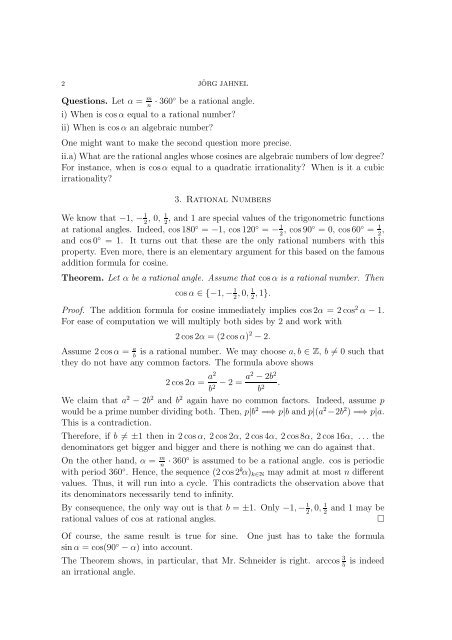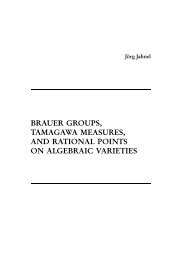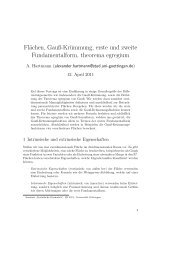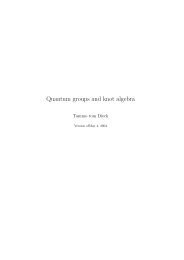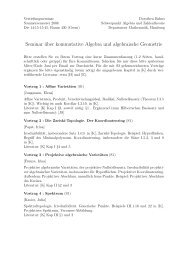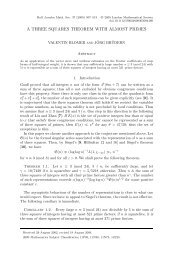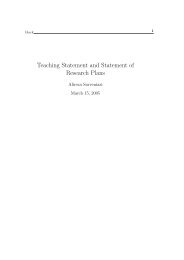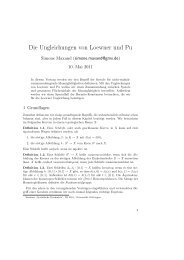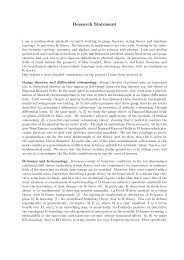SINE OF A RATIONAL ANGLE EQUAL TO A RATIONAL NUMBER?
SINE OF A RATIONAL ANGLE EQUAL TO A RATIONAL NUMBER?
SINE OF A RATIONAL ANGLE EQUAL TO A RATIONAL NUMBER?
Create successful ePaper yourself
Turn your PDF publications into a flip-book with our unique Google optimized e-Paper software.
2 JÖRG JAHNEL<br />
Questions. Let α = m n · 360◦ be a rational angle.<br />
i) When is cos α equal to a rational number?<br />
ii) When is cos α an algebraic number?<br />
One might want to make the second question more precise.<br />
ii.a) What are the rational angles whose cosines are algebraic numbers of low degree?<br />
For instance, when is cosα equal to a quadratic irrationality? When is it a cubic<br />
irrationality?<br />
3. Rational Numbers<br />
We know that −1, − 1, 0, 1 , and 1 are special values of the trigonometric functions<br />
2 2<br />
at rational angles. Indeed, cos 180 ◦ = −1, cos 120 ◦ = − 1, cos 2 90◦ = 0, cos 60 ◦ = 1,<br />
2<br />
and cos 0 ◦ = 1. It turns out that these are the only rational numbers with this<br />
property. Even more, there is an elementary argument for this based on the famous<br />
addition formula for cosine.<br />
Theorem. Let α be a rational angle. Assume that cosα is a rational number. Then<br />
cos α ∈ {−1, − 1 2 , 0, 1 2 , 1}.<br />
Proof. The addition formula for cosine immediately implies cos 2α = 2 cos 2 α − 1.<br />
For ease of computation we will multiply both sides by 2 and work with<br />
2 cos 2α = (2 cosα) 2 − 2.<br />
Assume 2 cosα = a b is a rational number. We may choose a, b ∈, b ≠ 0 such that<br />
they do not have any common factors. The formula above shows<br />
2 cos2α = a2<br />
b − 2 = a2 − 2b 2<br />
.<br />
2 b 2<br />
We claim that a 2 − 2b 2 and b 2 again have no common factors. Indeed, assume p<br />
would be a prime number dividing both. Then, p|b 2 =⇒ p|b and p|(a 2 −2b 2 ) =⇒ p|a.<br />
This is a contradiction.<br />
Therefore, if b ≠ ±1 then in 2 cosα, 2 cos 2α, 2 cos 4α, 2 cos8α, 2 cos 16α, . . . the<br />
denominators get bigger and bigger and there is nothing we can do against that.<br />
On the other hand, α = m n · 360◦ is assumed to be a rational angle. cos is periodic<br />
with period 360 ◦ . Hence, the sequence (2 cos2 k α) k∈Æmay admit at most n different<br />
values. Thus, it will run into a cycle. This contradicts the observation above that<br />
its denominators necessarily tend to infinity.<br />
By consequence, the only way out is that b = ±1. Only −1, − 1, 0, 1 and 1 may be<br />
2 2<br />
rational values of cos at rational angles.<br />
□<br />
Of course, the same result is true for sine.<br />
sin α = cos(90 ◦ − α) into account.<br />
One just has to take the formula<br />
The Theorem shows, in particular, that Mr. Schneider is right. arccos 3 is indeed<br />
5<br />
an irrational angle.


